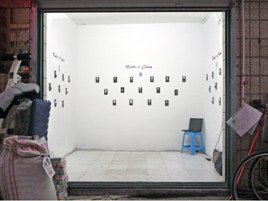兼容的盒子艺术计划第二十六期 bazaar compatible program #26
31°12.246'N 121°25.010'E
逐案进行 Case by Case
1/4 中间站 Intermediate Station 张新 Zhang Xin
2012/09/04 – 2012/09/09
2/4 葬礼的前期准备 Funeral Preparations 刘诗园 Liu Shiyuan
2012/09/11 – 2012/09/16
3/4 天问 Aerial 朱敬一 Zhu Jingyi
2012/09/18 – 2012/09/23
4/4 两元画廊 Two Yuan Gallery 翁志娟 Weng Zhijuan
2012/09/25 – 2012/09/30
每天8时30 - 20时30 开放 from 8:30am to 8:30pm everyday
安顺路98号 小商品市场内26号铺 Shanghai, 98 Anshun Road, stall 26
Case by Case _ The Case of AnShun Road
As a shortcut connecting urban and suburban areas in the concept of China city and town construction development, the grocery shopping street obviously plays the role as media of commodity exchange as well as daily life practice within mode of commercial economy, which presents as icon of political system at the same time. Nowadays, the grocery shopping street is no more the economical concept mode, but a mansion built on the basis of sociology mixing various ideologies, e.g. City migration, village reform, local protection awareness in the economic development, even the extraordinary living status appendant to political science. Especially in present days, encouraged and influenced by social economy characteristics in China, the multiple living practice based on commodity media exchange seems to deviate from the ideology while in fact it is the explanation form for presenting ideology itself through careful observation.
Taking grocery shopping street as exhibiting space, no only focusing on the art behaviour deviating from art history and exhibition hall, but also showing the importance of a kind of practical experience with the essence as how to take an non-site artistic action deviating from artistic form but still possessing availability to certain milestone position in the art history and raising the various questions beyond art itself inspirationally.
Configurated on the regulated art with deviated trial beyond the right of speaking, the artists complete a refreshingly new transition with non-exhibiting space media by which a contemporary form of crossing-over between art ego and environment or relying on landscape politics theory. During such activities, the artists are trying to sense various possibilities, i.e. How to actuate the art to deviate the original conceptual mode to certain open situation, how to conduct the subjective central awareness pattern to instant fashionable practice of edging power, moreover, how to interrupt art language after tracing the question of art ego by further understanding within postmodern context of landscaping ideology as well as art connotation possibilities. Overall, the attention will be paid to various questions regarding the reinterpretation beyond art itself through practice.
Zhang Xin
Shanghai, September 3, 2012
